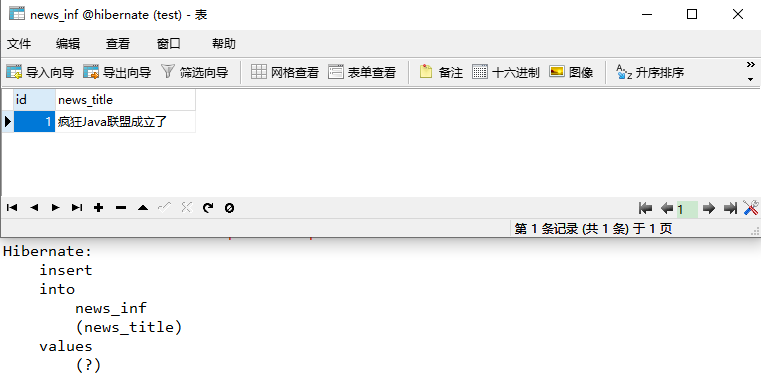Hibernate实战——@Transient注解
一 配置
<?xml version="1.0" encoding="GBK"?><!DOCTYPE hibernate-configuration PUBLIC"-//Hibernate/Hibernate Configuration DTD 3.0//EN""http://www.hibernate.org/dtd/hibernate-configuration-3.0.dtd"><hibernate-configuration><session-factory><!-- 指定连接数据库所用的驱动 --><property name="connection.driver_class">com.mysql.jdbc.Driver</property><!-- 指定连接数据库的url,其中hibernate是本应用连接的数据库名 --><property name="connection.url">jdbc:mysql://localhost/hibernate</property><!-- 指定连接数据库的用户名 --><property name="connection.username">root</property><!-- 指定连接数据库的密码 --><property name="connection.password">32147</property><!-- 指定连接池里最大连接数 --><property name="hibernate.c3p0.max_size">20</property><!-- 指定连接池里最小连接数 --><property name="hibernate.c3p0.min_size">1</property><!-- 指定连接池里连接的超时时长 --><property name="hibernate.c3p0.timeout">5000</property><!-- 指定连接池里最大缓存多少个Statement对象 --><property name="hibernate.c3p0.max_statements">100</property><property name="hibernate.c3p0.idle_test_period">3000</property><property name="hibernate.c3p0.acquire_increment">2</property><property name="hibernate.c3p0.validate">true</property><!-- 指定数据库方言 --><property name="dialect">org.hibernate.dialect.MySQL5InnoDBDialect</property><!-- 根据需要自动创建数据表 --><property name="hbm2ddl.auto">update</property><!--①--><!-- 显示Hibernate持久化操作所生成的SQL --><property name="show_sql">true</property><!-- 将SQL脚本进行格式化后再输出 --><property name="hibernate.format_sql">true</property><!-- 罗列所有持久化类的类名 --><mapping class="org.crazyit.app.domain.News"/></session-factory></hibernate-configuration>
二 PO
package org.crazyit.app.domain;import javax.persistence.*;@Entity@Table(name="news_inf")public class News{// 消息类的标识属性@Id@GeneratedValue(strategy=GenerationType.IDENTITY)private Integer id;// 消息标题// @Column指定该属性映射的列信息,此处指定了列名、长度@Column(name="news_title" , length=50)private String title;// 消息内容@Transientprivate String content;// id的setter和getter方法public void setId(Integer id){this.id = id;}public Integer getId(){return this.id;}// title的setter和getter方法public void setTitle(String title){this.title = title;}public String getTitle(){return this.title;}// content的setter和getter方法public void setContent(String content){this.content = content;}public String getContent(){return this.content;}}
三 测试
package lee;import org.hibernate.*;import org.hibernate.cfg.*;import org.hibernate.service.*;import org.hibernate.boot.registry.*;import org.crazyit.app.domain.*;public class NewsManager{public static void main(String[] args)throws Exception{// 实例化Configuration,Configuration conf = new Configuration()// 不带参数的configure()方法默认加载hibernate.cfg.xml文件,// 如果传入abc.xml作为参数,则不再加载hibernate.cfg.xml,改为加载abc.xml.configure();ServiceRegistry serviceRegistry = new StandardServiceRegistryBuilder().applySettings(conf.getProperties()).build();// 以Configuration实例创建SessionFactory实例SessionFactory sf = conf.buildSessionFactory(serviceRegistry);// 创建SessionSession sess = sf.openSession();// 开始事务Transaction tx = sess.beginTransaction();// 创建消息对象News n = new News();// 设置消息标题和消息内容n.setTitle("疯狂Java联盟成立了");n.setContent("疯狂Java联盟成立了,"+ "网站地址http://www.crazyit.org");// 保存消息sess.save(n);// 提交事务tx.commit();// 关闭Sessionsess.close();sf.close();}}
四 测试效果






























还没有评论,来说两句吧...